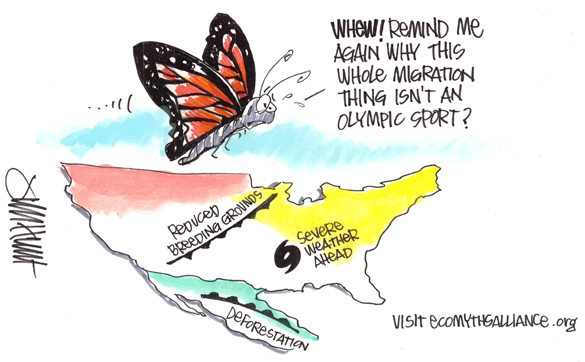Though it’s the state insect of Illinois, the beloved North American monarch butterfly is losing breeding ground in the Midwest.
Scientists say the skyrocketing use of herbicide-resistant GMOs is to blame.
Evidence for their case is mounting in Mexico’s Monarch Butterfly Biosphere Reserve, where 95 percent of the Eastern U.S. and Canada’s monarchs migrate every winter, providing scientists with the most accurate portrait of continental populations. According to the latest numbers, monarchs now occupy the smallest area in recorded history, with population estimated at 33 million, compared with 1 billion in 1996.
Why aren’t more butterflies making it to their subtropical destination? Deforestation and severe weather play a role, but many monarch scientists see a striking—and sobering—link between the rise of GMO agriculture and the declining monarch population.
Genetically modifying our way out of monarch favor
Let’s take a step back (or, um, a few thousand). For 10,000 years, eastern monarch butterflies have wintered in Mexico. What has lured them back north every spring for all those years? The promise of abundant milkweed, the monarch larvae’s host plant, which was traditionally so plentiful in the Midwest that roughly half of Mexico’s overwintering population came from these areas. Yes, even with the rise of industrial agriculture in the 20th century, milkweed still flourished here, dotting the edges of even the biggest agricultural fields.
Fast forward to recent years: Midwestern milkweed growth has tanked, with a 58 percent decrease between 1999 and 2010, triggering an estimated 81 percent decline in Midwest monarch production.
That’s about the same time that herbicide-resistant soy and corn crops began to take off, meaning that glyphosate, a non-selective, systemic weed killer, could be used to kill weeds (yes, including milkweed), without actually killing the crops. Its rise was meteoric. According to the USDA, 93 percent of planted soybean acres are now herbicide-tolerant, as are 85 percent of cornfields. The EPA reports glyphosate is the most commonly used pesticide in the U.S., with 180 to 185 million pounds sprayed annually—a figure that has more than doubled since 2001.
That’s more than a coincidence to the nation’s foremost monarch experts. Karen Oberhauser, PhD, calls GMOs “the smoking gun,” while Lincoln Brower, PhD, cites it as the “number one culprit” in monarch declines.
The good news is that we can help by:
- Supporting GMO labeling legislation
- Participating in Journey North‘s monarch counts
- Asking local officials not to spray herbicides on public land
Green Family Activity: Want to work with your little one to “make it better” for monarchs? Create a GMO-free, monarch-friendly zone in your yard together. This handy Monarch Waystation Seed Kit by Monarch Watch provides three types of milkweed and six types of nectar plant seeds to create a monarch-friendly garden. You can then certify it—and even make it official with a sign—to support the larger cause and inspire monarch conservation convos across your neighborhood.
Psssst: For more deets on the science behind all this, read the myth written by EcoMyths Alliance.


